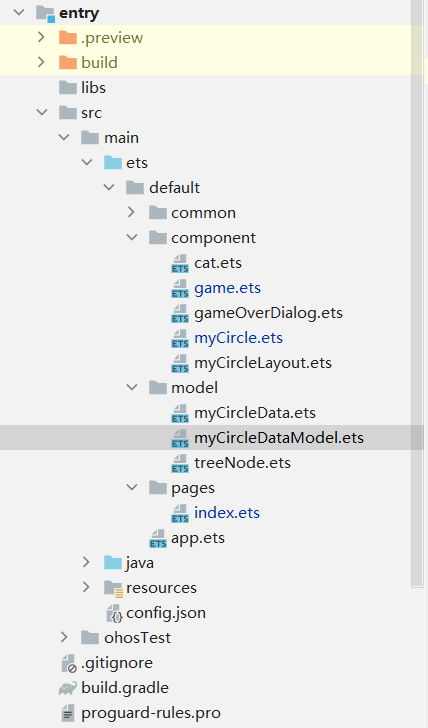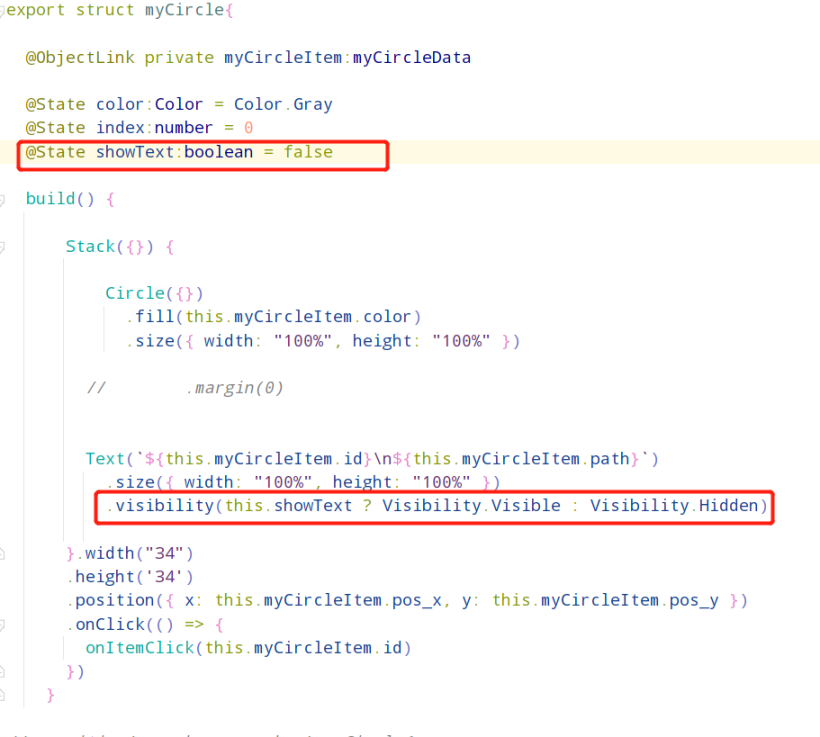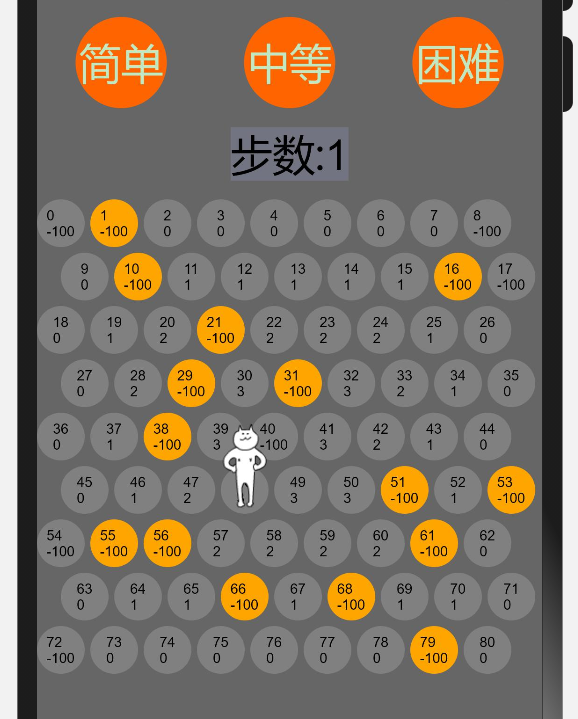HarmonyOS纯ets语言实现抓住神经猫游戏

1、前言
<<抓住神经猫>>游戏相信不少朋友都玩过,最近不是ARKUI挺火热的么,一直搞嵌入式的也想尝尝鲜,想找个小玩意入门,想起来5,6年前看过的一篇文章,分析神经猫的寻路算法,号称是最难抓住的神经猫,回去一看,这项目不正好练手吗,说干就干。
2、效果
目前已完成整个游戏的UI(当然图是网上找的),游戏逻辑(启动,移动,胜负判定),可以学到的知识:ets方式的UI布局,ets组件化开发思想,自定义弹出框,ets语言构造多叉树,广度优先算法,最小路径算法,设置图片动画等等,整体开发下来UI地方还算顺畅,难到不难,只是这种声明式UI和以前的命令式UI的编程方式需要一个思路转变,最费时间的地方是那个猫跑路的算法,算法本来是薄弱项,这下正中软肋了,不过好在翻了好几本书,找了些资料,再看了点视频,就搞定了,废话少说,来个动图感受一下。
先来个失败的:

再来个成功的:

3、关键部分解读
(1) 玩法
游戏的地图是一个9*9交错排列的一些灰色小圆点,初始情况下游戏生成地图的时候会随机选一些点变成橙色做为墙,然后玩家每次点击一个灰色圆点,圆点变成橙色,同时猫移动一步,关于胜负的判定是猫被圈进一个圈子里面就为赢,当猫跑到地图边边上就为输.玩法还是挺简单的。
(2) 部分代码
代码结构长这样,因为时间关系,代码的结构还没有优化,有些地方看起来很是很混乱,包括文件名,变量名那些,后面有时间再调整吧,目前就将就看一下吧。

再贴个”猫”类吧:
@Observed
export class catData{
pos_x:number
pos_y:number
location:number
step:number = 0
inWall:boolean=false
constructor(loc:number = defaultLocation){
this.setLocation(loc)
}
reset(){
this.inWall = false
this.step = 0
this.setLocation(defaultLocation)
}
setLocation(loc:number){
console.log("set Loction:"+loc)
this.location=loc
this.setPosition()
}
setPosition(){
let col:number = Math.floor(this.location/9)
let row:number = this.location%9
this.pos_x = (col%2 ? row*38+17:row*38)
this.pos_y = col*38
// console.log("x:"+this.pos_x+" y:"+this.pos_y)
}
moveTo(location:number) {
this.setLocation(location)
this.step++
}
catInWall(yes:boolean=true){
this.inWall = yes
}
}
猫类的主要功能就是记录移动步数,然后移动位置,当游戏重新开始的时候某些属性复位。
(3) 主要逻辑
游戏的主要逻辑就是靠玩家点击圆点发生,当点击圆点的时候,先将该点置为墙,然后先要找出猫能逃跑的路线,再让猫选择一条路线进行逃生,主要逻辑的代码如下:
export function onItemClick(index : number){
console.log("onItemClick "+index)
if(myCircleDataArray[index].clicked ){
console.log("不能点击")
return;
}
myCircleDataArray[index].setClick()
let catLocation = myCat.location
myCircleDataArray.forEach(item=>{
item.path = -100
item.depth = 100
})
myCircleDataArray[catLocation].depth=0
let neighbors = getNeighbors(catLocation,myCircleDataArray[catLocation].depth)
neighbors.forEach(item=> {
myCircleDataArray[item.location].depth=item.depth
})
let neighborList:Array<Neighbor> =neighbors
while(neighborList.length > 0){
let neighborsArrayList:Array<Neighbor> = []
neighborList.forEach(item=>{
let neighborsTemp = buildNeighborChild(item)
neighborsTemp.forEach(item=>{
neighborsArrayList.push(item)
})
})
neighborList = neighborsArrayList
}
neighbors.forEach(item=>{
calcCirclePath(item)
})
let best = getBestNeighbor(neighbors)
console.log("the best neighbor is:"+best.location+" path="+best.path);
if(best.path == 100){
console.log("cat is in wall");
myCat.catInWall()
myGame.setState(gameState.gameVictory)
}
myCat.moveTo(best.location)
if(catCheckLocation() == true){
console.log("cat escaped")
myGame.setState(gameState.gameFailed)
}
neighbors.length = 0
}
关于寻路算法这里说一下,目前采用的是广度优先遍历,在找到几条最短路径,当有两条以上的最短路径的时候,就看一下哪条路径下的子路径比较多(防止走入玩家设定的陷阱)。
function getBestNeighbor(neighbors:Neighbor[]):Neighbor{
let neighbor:Neighbor = neighbors[0]
//already get the shortest path
for(var i=1;i < neighbors.length;i++){
if(neighbor.path > neighbors[i].path){
neighbor = neighbors[i]
}
}
console.log("the shortest nei:"+neighbor.location)
//select the child more than other
for(var j=0;j < neighbors.length;j++){
if(neighbor.path == neighbors[j].path){
console.log("find same path:"+neighbors[j].location)
if(neighbor.child.length < neighbors[j].child.length){
neighbor = neighbors[j]
console.log("changed neighbor:"+neighbor.location)
}
}
}
return neighbor
}
开发的时候设置一个调试小技巧效率高很多(然而一开始的时候我也是个铁憨憨,在草纸上记,弱爆了):

当把这个置true的时候可以清晰的看到点的位置和到达边界需要的步数,神经猫真是通过这个来跑路的,看一下打开的效果:

4、补充
(1) 后续
后续需要做的事情主要是以下几件:
当前可以看到3个难度图标,目前还没做功能,后续会加上,难度的调节目前认为有几个地方:
初始墙的数量,逃跑算法的强度,或者优化初始墙的位置(简单的话就相对集中,困难的话就相对分散),以我非数学专业的功力感觉第一种靠谱一些,如果有数学大神也可以探讨一下后面两种怎么做。
可以看到猫逃跑的时候,从当前位置移动到下一位置,会出现短暂的消失,这有可能是模拟器在渲染动图的时候有什么延时导致的,后期准备研究一下动画效果,让猫的走动更顺滑。
由于目前还没有OpenHarmony能玩起来的开发板,所以只能是模拟器演示,后续如果有真正的开发板的话,相信很快看就能移植上去。
(2) 关于代码
目前代码托管在Gitee上,感兴趣的小伙伴可以下载过来试一下,如果有什么建议或者改动也可以提提PR,提一下,这个游戏别看简单,拿来入门练手还是非常合适的,如果一开始就搞什么复杂的界面或者交互很可能会打击信心的哈。
代码地址:https://gitee.com/yegren/CrazyCat。

 蜀ICP备20004578号
蜀ICP备20004578号